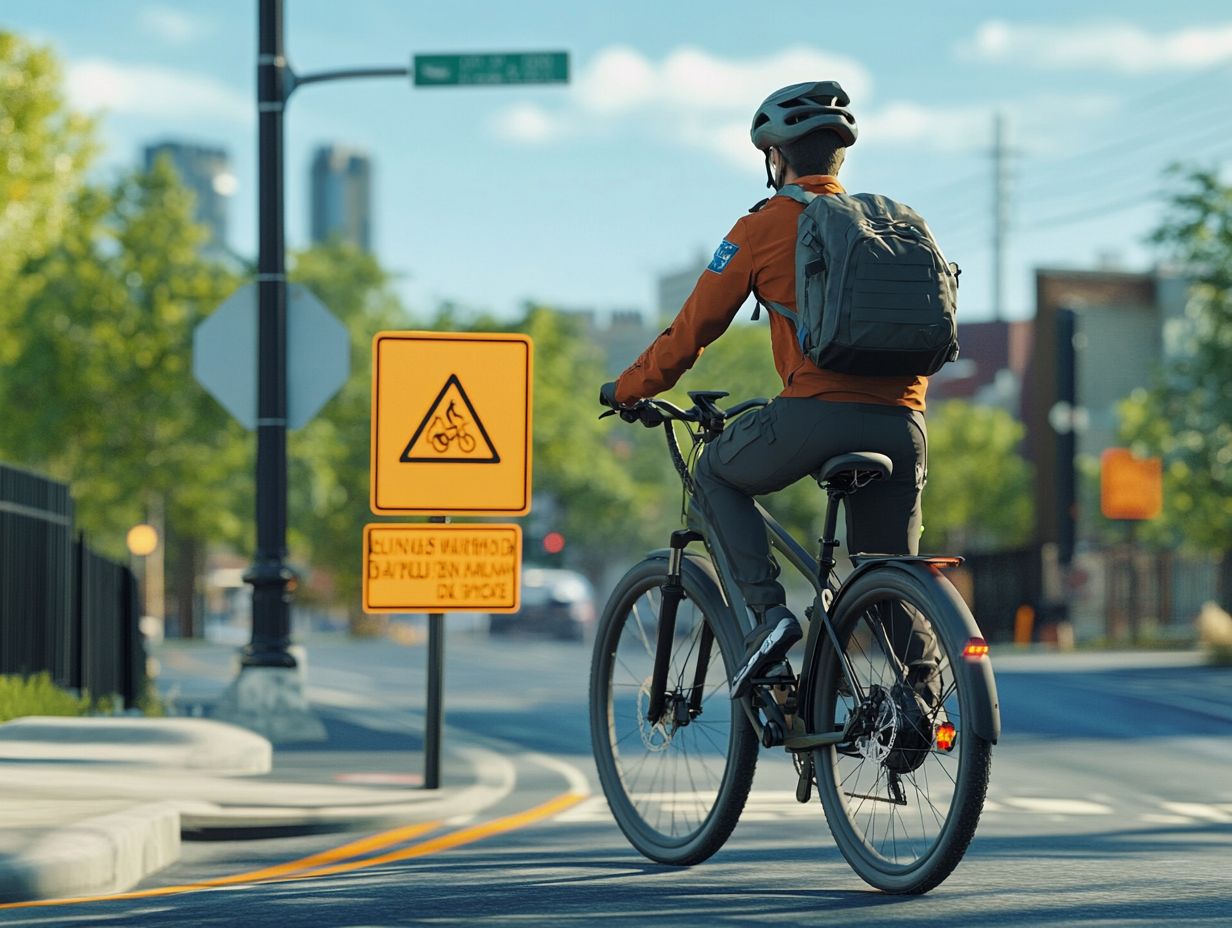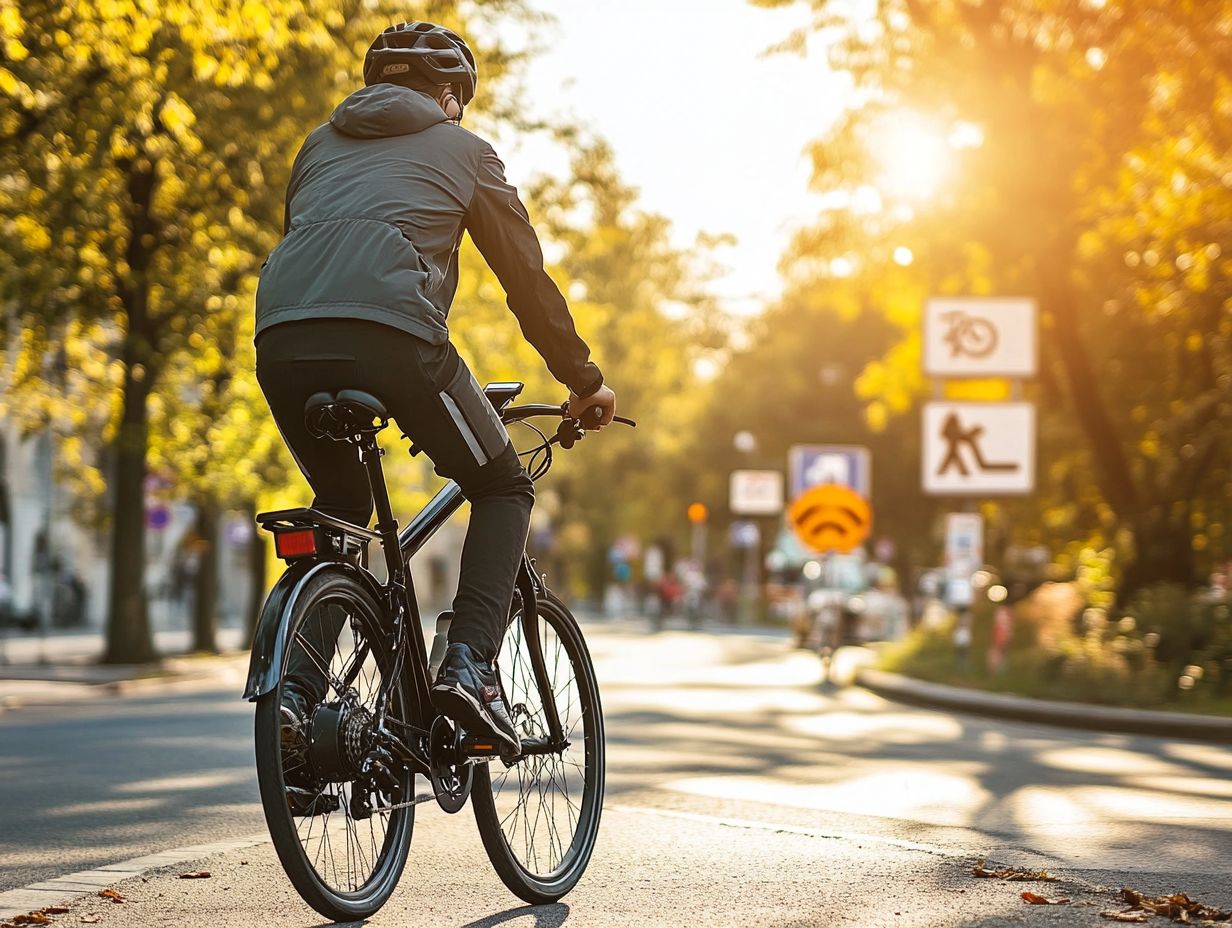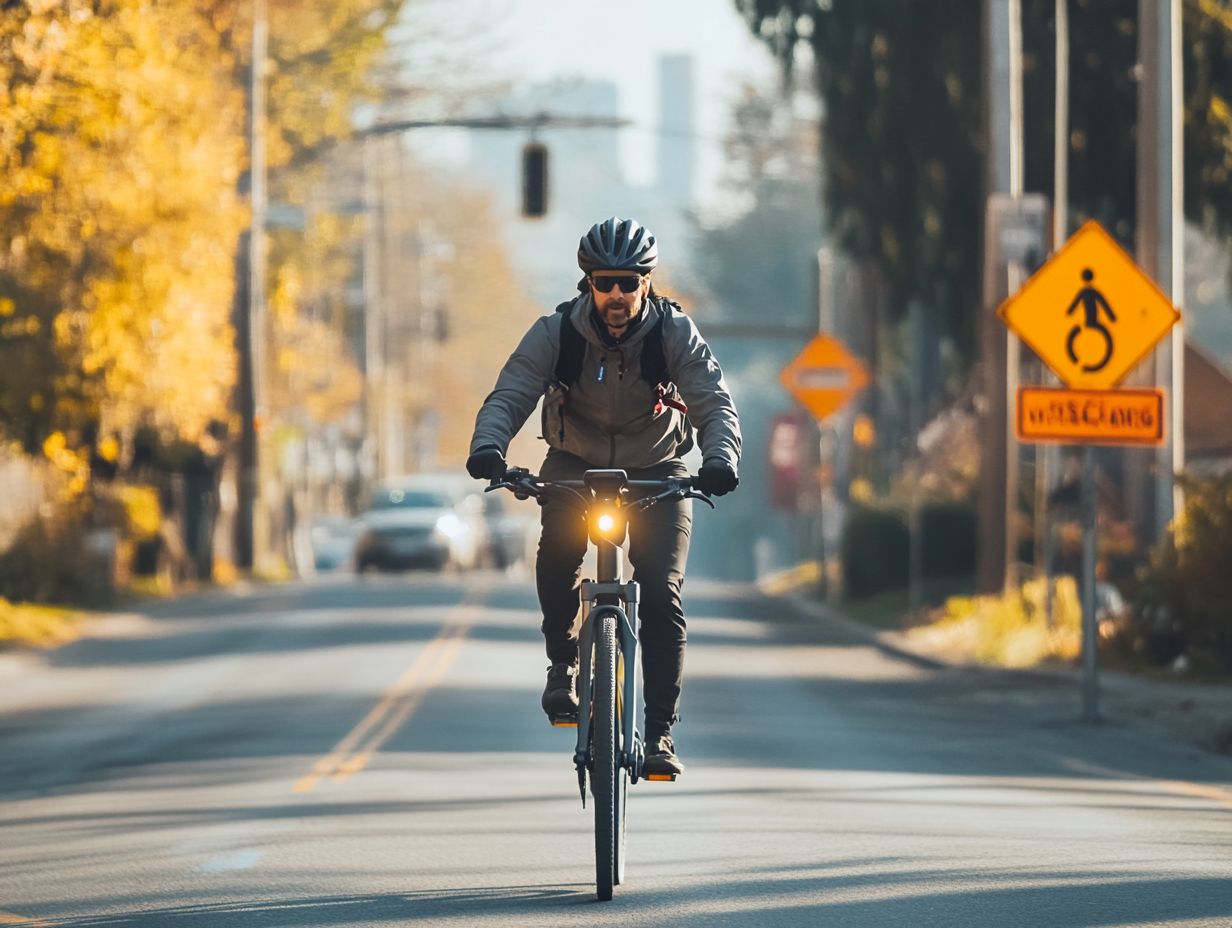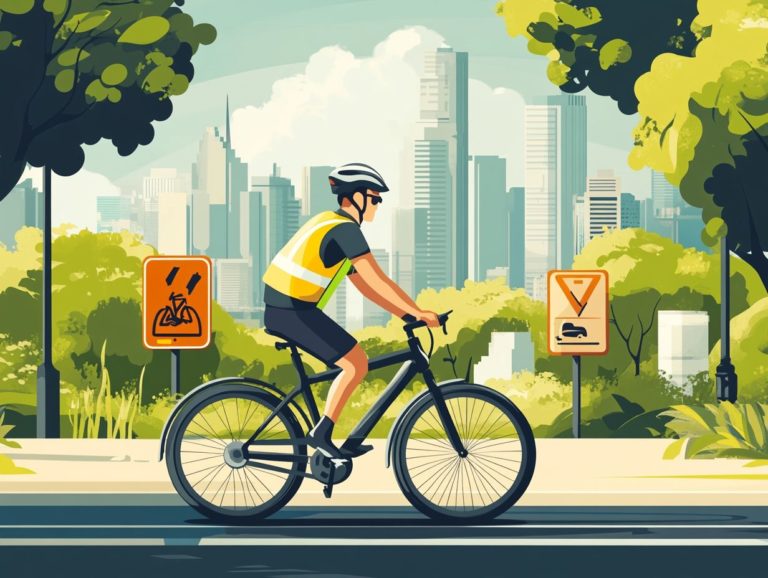Electric Bicycle Regulations and Safety Guidelines
Electric bicycles, or e-bikes, are becoming a popular choice for sustainable transportation. They offer an efficient way to travel while being eco-friendly.
When exploring electric bikes, you ll face specific rules and responsibilities. Knowing these helps ensure safety and compliance.
This article is your essential guide to riding electric bikes safely and enjoying all their benefits!
Contents
- Key Takeaways:
- Overview of Electric Bicycle Regulations
- Safety Guidelines for Riding an Electric Bicycle
- Benefits of Electric Bicycles
- Maintenance and Care for Electric Bicycles
- Choosing the Right Electric Bicycle
- Frequently Asked Questions
- 1. What are the regulations for riding an electric bicycle on public roads?
- 2. Are there any age restrictions for riding an electric bicycle?
- 3. Do I need a license to ride an electric bicycle?
- 4. Are there any speed limits for electric bicycles?
- 5. Are there any safety guidelines I should follow while riding an electric bicycle?
- 6. Can electric bicycles be ridden on bike paths or trails?
Key Takeaways:

- Always know your local laws about electric bicycles. This keeps you safe and avoids legal issues.
- Wear safety gear and follow traffic rules like traditional cyclists. Signal your turns and use bike lanes.
- E-bikes help reduce carbon emissions and boost fitness. Regular maintenance is key to keeping your bike in top shape.
Overview of Electric Bicycle Regulations
Electric bicycles, or e-bikes, have surged in popularity lately, prompting lawmakers across the United States to craft a set of rules. E-bike laws can vary dramatically from state to state and even between local jurisdictions, leading to a fair bit of confusion for consumers.
Organizations such as PeopleForBikes advocate for clearer regulations that prioritize safety and support the growth of electric bike usage. For example, California has its own distinct classifications for e-bikes, while New York City has implemented a unique set of rules.
This all contributes to an intricate legal maze that you must navigate as an e-bike user.
Understanding Local Laws and Regulations
Understanding local laws and regulations surrounding electric bikes is essential to avoid accidents and legal complications.
Each region has its unique rules, including specific state regulations, that can significantly influence how e-bikes operate on public roads. Take California, for example, where the law categorizes e-bikes into three distinct classes, each with specific restrictions regarding motor power and top speeds. To ensure safety while riding, it’s crucial to be equipped with the right electric bicycle safety gear you need.
It s vital to recognize the age restrictions, especially for Class 3 e-bikes, which mandate that riders be at least 16 years old and wear a helmet.
On the other hand, New York City has its stringent regulations, including strict licensing requirements and a ban on specific high-powered models. Familiarizing yourself with local laws is crucial for ensuring both safety and compliance.
Safety Guidelines for Riding an Electric Bicycle
Riding an electric bicycle safely transcends mere enjoyment; it requires a keen awareness of potential risks and a commitment to following safety guidelines that can prevent accidents and injuries. E-bike safety protocols are vital, whether you re utilizing pedal-assist (helping you pedal) or throttle-assist (controlling speed with a throttle) modes.
While helmet laws may differ by state and locality, wearing a helmet is universally acknowledged as a best practice for ensuring your safety. Understanding road safety measures is also crucial.
Grasping the nuances of bike paths and the intricacies of traffic laws is essential for an optimal and secure riding experience.
Proper Gear and Equipment

Having the right gear is essential for your e-bike safety. It reduces the risk of accidents and injuries.
Local helmet laws emphasize the importance of wearing a helmet for protection during every ride. Beyond a well-fitted helmet, consider these critical safety items:
- Bright lights to boost your visibility during evening rides.
- Reflective clothing that attracts the attention of passing vehicles.
Carrying basic maintenance tools is invaluable for tackling minor issues on the go. This allows you to resolve problems swiftly and continue your adventures without interruption.
By equipping yourself with these essential items, you significantly elevate your safety and enjoyment while navigating the roads.
Rules of the Road
Knowing the rules of the road is crucial for electric bike riders. It can keep you safe and make your rides more enjoyable!
Understanding local traffic laws boosts your safety and enhances your overall riding experience. Electric bike riders must be aware of designated bike paths, obey traffic signals, and the specific laws governing e-bike usage in their states.
For instance, some areas allow e-bikes on sidewalks, while others impose strict prohibitions. The rules can vary widely from one state to another.
In a bustling environment like New York City, maintaining vigilance is paramount. Use designated bike lanes, signal your turns, and wear a helmet!
Being well-acquainted with local regulations and adopting smart riding practices can significantly make your journey smoother and more secure.
Benefits of Electric Bicycles
Electric bicycles offer numerous advantages that transcend mere transportation. They positively influence your health, the environment, and your overall safety as a consumer.
As an eco-friendly alternative to conventional vehicles, e-bikes reduce carbon emissions and champion sustainable commuting practices.
Additionally, e-bikes encourage physical activity. They boost your cardiovascular health and make your daily commute more enjoyable.
As urban areas grapple with congestion, choosing electric bikes eases road traffic and contributes to a healthier lifestyle and safer urban settings.
Environmental and Health Benefits
The environmental advantages of electric bikes are remarkable. They play a crucial role in reducing your carbon footprint and fostering sustainable commuting.
Research suggests that by cycling, you could decrease your CO2 output by approximately 1,000 pounds annually compared to traditional cars. As electric bikes gain traction, urban areas enjoy diminished traffic congestion, leading to shorter travel times and improved air quality.
But the perks don t stop there; there are significant health benefits for you as a rider. Regular cycling can elevate your cardiovascular fitness, strengthen muscles, and enhance mental well-being.
In fact, studies show that just 30 minutes of moderate activity, like biking, can elevate your mood and sharpen cognitive function.
Electric bikes stand out as a dual solution, catering to both ecological and health-focused aspirations.
Maintenance and Care for Electric Bicycles

Proper maintenance and care for your electric bicycle are vital for ensuring safety, longevity, and peak performance. As an e-bike owner, you must not overlook this aspect.
Regular check-ups and troubleshooting serve as a proactive measure to prevent accidents and injuries from technical malfunctions or neglect. Following maintenance protocols significantly enhances your e-bike’s lifespan and ensures compliance with safety features that protect you and others on the road.
Regular Maintenance and Troubleshooting
Regular maintenance maximizes the longevity and performance of your electric bike. Routine checks allow you to identify and address potential issues before they escalate.
Establishing a maintenance schedule ensures that every critical aspect is covered. This includes inspecting the battery connections for corrosion and evaluating the brakes for optimal response. Monitoring tire pressure enhances efficiency and extends tire life. Neglecting these checks could lead to diminished performance or even accidents.
Here are some easy troubleshooting tips that can save you time and money! Check for loose wires and ensure the motor is functioning properly. Committing to regular upkeep elevates your e-bike’s performance and enhances your safety as a rider.
Choosing the Right Electric Bicycle
Selecting the ideal electric bicycle requires thoughtful consideration of key factors that influence your riding experience. Assess motor power, battery life, and the type of assistance. Pedal-assist helps you when you pedal, while throttle-assist gives you power without pedaling.
With many options available today, it’s easy to feel overwhelmed. Reflecting on your riding style and personal preferences can streamline the decision-making process. Evaluate these elements meticulously to ensure the e-bike you choose meets your requirements and adheres to legal specifications and safety standards.
Factors to Consider
When selecting an electric bike, consider several key factors, such as motor power, battery capacity, and the type of assistance that best suits your riding style.
Making the right choice can enhance the bike’s performance and your overall comfort during rides. A more robust motor can tackle steep inclines and heavier loads, perfect for hilly landscapes or transporting cargo. Battery capacity affects how far you can ride on a single charge, which is crucial for longer commutes or day trips.
The choice between pedal-assist and throttle-assist shapes your riding experience. Pedal-assist offers a more organic feel, while throttle-assist provides instant acceleration for heightened control.
For urban settings, a mid-range motor may suffice. If you re adventurous and eager to explore rugged trails, opt for higher motor power to ensure speed and agility on various terrains.
Frequently Asked Questions

1. What are the regulations for riding an electric bicycle on public roads?
The regulations for riding an electric bicycle on public roads vary by state and country. Check with your local government to ensure you follow all applicable laws.
2. Are there any age restrictions for riding an electric bicycle?
Age restrictions may vary by location. Some areas require riders to be at least 16 years old, while others may have no restrictions. It’s best to check with your local government.
3. Do I need a license to ride an electric bicycle?
In most cases, you don t need a license to ride an electric bicycle. Check your local regulations, as some areas might require a valid driver’s license.
4. Are there any speed limits for electric bicycles?
Some states or countries have speed limits for electric bicycles, while others do not. Know the maximum speed allowed in your area and always ride responsibly.
5. Are there any safety guidelines I should follow while riding an electric bicycle?
Yes! Follow these safety guidelines:
- Wear a helmet.
- Follow traffic rules.
- Use hand signals to indicate turns.
Stay safe!
6. Can electric bicycles be ridden on bike paths or trails?
This varies by location, but generally, electric bicycles are allowed on bike paths and trails unless restricted. Be respectful of other cyclists and pedestrians while riding.



